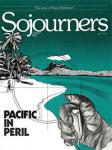Thirty-eight years ago this month, two U.S. bombers took off three days apart from the Pacific island of Tinian, at that time the largest airfield in the world. Their destinations: the Japanese cities of Hiroshima and Nagasaki. The atomic bombings of those two cities on August 6 and 9 marked a negative milestone in human history, launching the nuclear age and claiming the Pacific as both base of operations and first target.
Since World War II, the U.S. military has been running a nuclear bulldozer over the Pacific, uprooting Pacific people from their land, flooding the environment with radiation, and even obliterating, several islands through nuclear tests. While other peoples around the globe speculate on the horrors of potential nuclear war in their locales, the people of the Pacific have already been made victims of the nuclear age.
As early as three months after the Hiroshima and Nagasaki bombings, in November of 1945, the U.S. military began searching for an appropriate testing site for further nuclear experiments. Spurred on by the "success" of the Hiroshima and Nagasaki missions, the U.S. government began to move full speed ahead on nuclear development.
In January of 1946, it announced that, the Bikini Atoll in the Marshall Islands fulfilled all the geographical and climatic requirements for a testing site--one of its major geographical pluses being that it lies 4,500 miles from the U.S. mainland. The people of Bikini were moved off their island, the first in a string of mass evictions to make room for U.S. testing ranges and airstrips.
More dangerous than the poverty and overcrowding of the U.S.-designated resettlement areas is the poison the U.S. has introduced into the Pacific environment. Atomic testing and dumping of radioactive waste on the islands have created a legacy of sickness, including thyroid and other cancers, cataracts, and birth defects. The response of the U.S. government to the pleas of the Pacific people to inform them of the dangers has been marked by cover-ups of the truth and refusals to acknowledge any exposure to harm. At the same time, the government has put out statements declaring radiation-exposed Pacific people to be important specimens for the study of radiation effects on humans.
The Pacific Islanders are a deeply Christian people with communitarian values, who believe that God's gifts of land and sea, which to them equal life, are to be shared and preserved by all. They are coming together in the Nuclear-Free and Independent Pacific Movement to say no to U.S. abuses of their home.
Pacific people are confronting U.S. dominance and paternalism through both political channels and acts of nonviolent resistance. Some have risked their lives by placing themselves on missile targets during U.S. tests, literally putting their bodies between their sacred land and U.S. power. They are courageously forging a resistance movement that combines Christian faith with the struggles for self-determination and the abolition of nuclear weaponry.
Charles Manata, a high-school student from the Solomon Islands, voiced the concern of his people in his winning poster for the Pacific Conference of Churches Nuclear-Free Pacific competition. Speaking to us, as well as to the Japanese, who have targeted his home for radioactive waste dumping, and the French, who continue to conduct atmospheric nuclear tests, he stated what has become a slogan for the Nuclear-Free Pacific Movement: "If it is safe, dump it in Tokyo, test it in Paris, store it in Washington; but keep my Pacific nuclear-free!"
It is our tradition at Sojourners to focus our August issue each year so that it commemorates the bombings of Hiroshima and Nagasaki. Those bombings are a sin of which the United States has never repented. Instead, U.S. nuclear policy has moved ahead to claim more and more victims.
In a spirit of repentance, we outline in this issue the shameful U.S. history toward the people of the Pacific. And we offer their hope and faith as an act of solidarity with the struggle of a people who daily suffer from U.S. preparations for nuclear war.
The damage that has been done in the Pacific can never be undone. Islands cannot be recreated, nor can radiation be siphoned away. The effects will linger for centuries. But we can stand with those people of the "Peaceful Ocean" who simply desire to live in harmony with their land and one another; and we can receive their faith and courage as a gift.
The Pacific Islands have been showered with U.S.-packaged danger because, from where the Pentagon sits, they are on the periphery of the globe. But we have learned that from the margins of power often comes the clearest articulation of the truth. Those who love their land wonder what has happened to the soul of a nation whose technology is destroying a corner of God's creation. Those who value the Spirit of God that dwells in every human life ask how a powerful nation could make a whole people pawns in nuclear target practice.
Their questions must make us take a second look at ourselves. We pray that those questions might also be heard by the wielders of power in our nation, who must find ears to hear a simple plea for peace.
Joyce Hollyday was associate editor of Sojourners when this article appeared.

Got something to say about what you're reading? We value your feedback!
